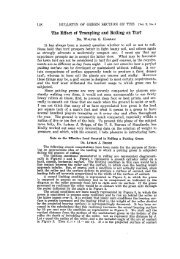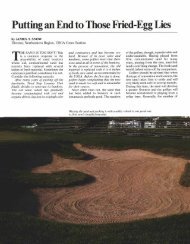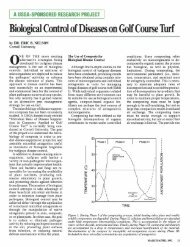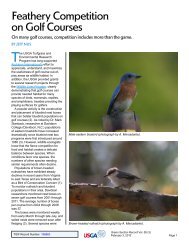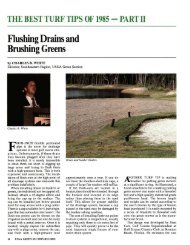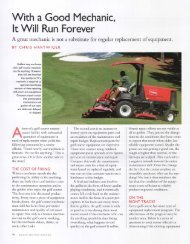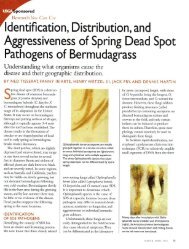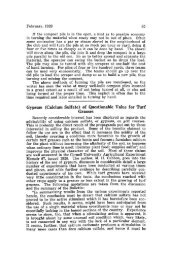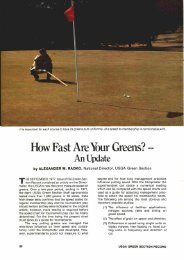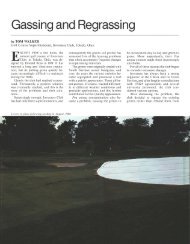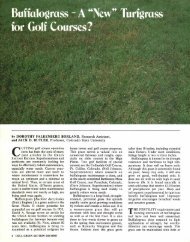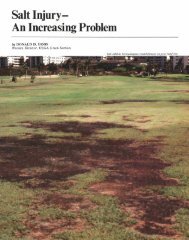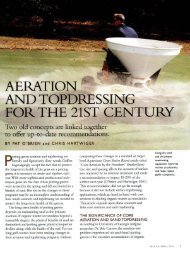Guidelines for Building Great Tees - USGA Green Section Record
Guidelines for Building Great Tees - USGA Green Section Record
Guidelines for Building Great Tees - USGA Green Section Record
- No tags were found...
Create successful ePaper yourself
Turn your PDF publications into a flip-book with our unique Google optimized e-Paper software.
<strong>Tees</strong> should havemultiple entranceand exit points sothat traffic is notconcentrated in asmall area. Thistee corrected thetraffic problem byconstructing a largestair area to dispersefoot traffic.<strong>Green</strong> <strong>Section</strong> agronomists are often askedwhy the <strong>USGA</strong> doesn't provide specifications<strong>for</strong> the construction of tees.Although many articles have appeared in the<strong>Green</strong> <strong>Section</strong> <strong>Record</strong> discussing various aspects oftee maintenance, few have addressed tee constructiondirectly. As most are aware, we haveprovided very detailed recommendations <strong>for</strong>putting green construction <strong>for</strong> more than 40years, so it would seem reasonable to expect the<strong>USGA</strong> to follow a similar <strong>for</strong>mat <strong>for</strong> tees as wellas bunkers and other facets of golf courseconstruction.To better understand why we have beenreluctant to write guidelines <strong>for</strong> tee construction,a brief semantics lesson is in order. There is a verylarge difference in the meaning of the wordsrecommendations and specifications.When it comesto the construction of greens, the <strong>USGA</strong> has longpublished the <strong>USGA</strong> Recommendations <strong>for</strong> aMethod of Putting <strong>Green</strong> Construction. This documentdetails what the <strong>USGA</strong> <strong>Green</strong> <strong>Section</strong> feelsis the best way to build greens. When these recommendationsare referenced in a contract as the constructionmethod to be followed, they becomecontract specifications.When it comes to greens, the <strong>USGA</strong> feels verystrongly that the recommendations should not bemodified.On the other hand, it has been ourexperience that tee construction need not be soprecise. The higher height of cut typically maintainedon tees promotes much stronger turf that,in turn, is much more tolerant of less-than-idealgrowing conditions. It is our belief that there area lot of ways to build good tees. Publishing asingle recommendation, which might in turn beutilized as a specification,could result in the eliminationof many other valid tee constructionmethods that might be more economical <strong>for</strong> aparticular project.Our hesitation to publish a single recommendedtee construction method does notprevent us from offering a number of guidelinesthat we feel will help ensure top-quality tees. Thefollowing suggestions should be incorporated intoevery tee constructionproject.20 G R E ENS E C T ION R E COR 0
SIZENo construction method will produce goodturf if the tee is too small <strong>for</strong> the amount of playit receives. For many years, the <strong>Green</strong> <strong>Section</strong>agronomists have utilized a tried-and-true ruleof thumb <strong>for</strong> tee size. For every 1,000 rounds ofgolf the tee receives each year, 100 square feet ofusable teeing area should be provided. Thus, a teethat receives 20,000 rounds per year should beconstructed to provide 2,000 square feet ofusable area.Note the phrase "usable area." Many tees meetthe square footage requirement in terms of lengthby width, but some have much less usable area<strong>for</strong> a variety of reasons. The surface may be sounlevel that only a small portion of the tee isactually used by golfers. A large portion of the teemay go unused as a result of trees that encroachinto the target line, <strong>for</strong>cing players to one side orthe other. Shade from surrounding trees oftenresults in turf that is so weak that a golfer cannottake a firm stance and thus will not use that areaof the tee. It also should be kept in mind that anytee that receives heavy iron play must be significantlylarger than the computed amount. Thesame typically is true <strong>for</strong> the number-one tee dueto the additional practice swings it must endure.Once again, this is only a rule of thumb. For amuch more detailed discussion on how to determineproper tee size, refer to Paul Vermeulen'sarticle entitled "Tailor-Made" in the Marchi April2002 issue of the <strong>Green</strong> <strong>Section</strong> <strong>Record</strong>.ACCESS<strong>Tees</strong> should have multiple entrance and exitpoints so that traffic is not concentrated in smallareas. Steps, planter boxes, cart path design, andsevere slopes all can result in severe wear on teesin spite of the tee being of sufficient size. Noamount of fertilizer, construction method, orturf grass species can completely overcome heavytraffic concentrated in a small area. The problemis greatly exacerbated if the tee is shaded; limitedlight and heavy traffic guarantee weak turf.SLOPES ON SIDES OF TEESTee banks or slopes can have a great impact onboth maintenance and golfer safety. From a maintenancestandpoint, steep slopes are difficult towater, fertilize, cultivate, and, most of all, mow.Mowing steep slopes frequently results in damageto the turf when the equipment struggles tomaintain uni<strong>for</strong>m traction. Crabbing is a term thatdescribes the tendency of a mower to slip sidewaysas it travels perpendicularly to the slope.Whenever the drive wheels of a mower losetraction, they chew up the turf.The same loss of traction results in a dangeroussituation <strong>for</strong> equipment operators. This is particularlytrue <strong>for</strong> the drivers of spray equipment, dueto the increased weight and load shifting of thetanks. To overcome such problems, many superintendentsfind the best option <strong>for</strong> maintainingsteep tee banks is to <strong>for</strong>go the use of large equipmentand rely instead on costly hand labor.Sands that containsome soil and organicmatter are easier tomaintain due to betterwater and nutrientretention. They alsoare more stableunderfoot.~_______,~~_.MAY-JUNE 2005 2\
From the golfer's standpoint, the combinationof steep tee slopes and spikeless shoes can result inslips and falls. This is particularly true anytime thegrass is damp. In an ef<strong>for</strong>t to prevent injury andpossible litigation, course operators often willbuild steps and ramps to provide a safer and lessstrenuousclimb to the teeing ground. Un<strong>for</strong>tunately,while such devices may help reduce theproblems associated with the steep slope, theyinvariably concentrate traffic to a single entranceand exit point. As already noted, this concentrationmakes weak turf inevitable.To avoid these problems, side slopes should bekept at 3: 1 (18 degrees) or less.LIGHTInsufficient light, coupled with insufficient size,are the two most common problems with tees.The two factors are physiologically linked. Everyoneremembers from grade school biology thatgreen plants produce the energy necessary <strong>for</strong>growth through photosynthesis. To maintain adense and attractive surface, the turf grass on teesmust grow faster than it is worn out. <strong>Tees</strong> that aretoo small <strong>for</strong> the traffic they receive cannotrecover quickly enough. Turfgrass grown on teesthat receive insufficient light grows much moreslowly due to reduced photosynthetic activity.Predictably, small, shaded tees generally are foundin extremely poor condition. It also should beremembered that the same trees that limit thelight to a tee are often close enough to competeaggressively with the turf <strong>for</strong> nutrients andmoisture.The <strong>Green</strong> <strong>Section</strong> recommends that teesreceive eight hours of direct sunlight per day.Thisdoes not mean that it is impossible to have a goodteeing surface with less than eight hours of light.A large tee with multiple entrance and exit pointsand limited iron play can per<strong>for</strong>m well with lessthan eight hours. Root pruning of the treesadjacent to the tee can make <strong>for</strong> an even morefavorable growing environment. Turfgrass selectioncan make a tremendous difference. Bentgrassesand ryegrasses are far more shade tolerantthan bermudagrasses. As a result, many southerncourses find that the only time they have goodturf on their shaded bermudagrass tees is whenthey are overseeded with rye grass <strong>for</strong> winter play.ROOTZONE SELECTIONMany different construction methods haveproven successful <strong>for</strong> tees. There are examples ofexcellent tees being maintained with rootzonescomposed of mixtures of sand, soil, and organicmatter. There are also good tees built from thematerial harvested from old greens when they arerebuilt, and even good tees built from straightsand. Predictably, each method has advantages anddisadvantages.An in<strong>for</strong>mal survey of the <strong>Green</strong> <strong>Section</strong> staffand many golf course superintendents revealedthat most turf grass managers would rather growturf on tees that have a rootzone that includessome soil. Soil combined with sand and organicmatter provides a stable surface with goodnutrient and moisture retention while at the sametime draining quickly enough to get the tee backinto play in a reasonable amount of time followingheavy rain. Rootzone mixes are expressed inratios of sand to organic matter to soil, with themost popular being 7:2:1 or 8:1:1.When a course decides to rebuild greens, it is agood idea to give strong consideration to overhaulingthe tees at the same time. Years of topdressing,aerification, and fertilization will almostcertainly result in significant improvement in theupper few inches of rootzone of the old greens.As a result, in most instances, the rootzonematerial removed from the old greens will proveexcellent <strong>for</strong> use on tees.Straight sand is the easiest to build with, andit drains very rapidly. However, it provides theleast favorable growing conditions in terms ofmoisture and nutrient retention. It also can bevery unstable in terms of playability <strong>for</strong> monthsand possibly years. If straight sand is used, it is vitalthat the sand be submitted to an accredited soiltestinglaboratory <strong>for</strong> analysis. The lab canper<strong>for</strong>m tests to determine how deep the sandshould be to ensure good drainage and improvedmoisture retention. They can also provide someinsight into stability issues, although this is not anexact science.SURFACE DRAINAGERegardless of the rootzone selected, every teeshould be constructed with a minimum of 0.5%slope on the tee top to ensure surface drainage ofexcess water away from the teeing ground. Fortunately,such precise grading has been mademuch easier with the advent of laser gradingequipment. As a general rule, the order of preference<strong>for</strong> the direction of the surface drainage isfront to back, right to left, left to right, and backto front. In reality, few, if any, golfers can sense22 G R E ENS E C T ION R E COR D
such a small degree of slope and thus the primarydeterminant <strong>for</strong> the direction of surface drainageshould be in which direction the water can bedischarged most efficiently. To avoid creatingslippery and unsafe conditions,considerationshould be given to the entrance and exit pointsused by golfers. On connected, multiple-tieredtees, care must be taken to avoid sending surfacewater to the area between a <strong>for</strong>ward and back tee.Doing so often results in water accumulating inthe transition area between the tVIOlevels.SUBSURFACE DRAINAGEEvery tee should also have subsurface drainage.Ideally, the subgrade of the tee should be shapedto direct excess water to a collection drain. Aslope of 1.0% to 2.0% will ensure that watermoves across the surface of the subgrade to thedrain line. Water should not move more than 15feet across the subgrade without being collectedby a drain. A drain line should also be installednear the edge of the tee to prevent water that hasmoved across the sub grade from bleeding out ofthe tee bank and causing maintenance and safetyproblems.ALIGNMENTThe alignment of rectangular tees with the targetarea is an issue that causes concern with manygolfers. Based on personal observations, golfershave little problem lining up their shots when thetee is pointing well off the target line - greaterthan 10 degrees. Golfer complaints regarding thisissue are most likely to occur when the tee is justslightly off line. This is likely more of an aestheticissue than one of playability. Regardless, it is anissue with many players and can be addressedeasily during construction.CONCLUSIONIn summary, while there are many ways to buildgood tees, the following points should be keptin mind to ensure a successful tee constructionproject.• Adequately size the tee based on how muchand what type of play it receives and the growingconditions of the site.• Provide multiple access points to spread golfertraffic over as large an area as possible .• Keep the slope of the tee sides at 3: 1 (18degrees) or less to provide safer conditionsplayers and course workers.<strong>for</strong>• The surface of the tee should receive a minimumof eight hours of direct sunlight per day.• A 7:2:1 or 8:1:1 sand/organic matter/soilrootzone generally provides excellent growingproperties.• Provide surface drainage slope of at least 0.5%regardless of the composition of the rootzone.• Slope the tee sub grade at least 1% to 2% tointerception drains spaced no greater than 15 feetapart. Install a drain at the edge of the tee toprevent "bleeding."• To avoid controversy regarding tee alignment,align rectangular tees directly with the target lineor else angle them greater than 10 degrees awayfrom the target line.JIM MOORE is the <strong>Green</strong> <strong>Section</strong>'s constructioneducation program director.There is a lot rightwith this golf coursetee, including plentyof light, unlimitedaccess points, easeof maintenance,and alignment.MAY - J U N E 200 5 23



